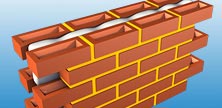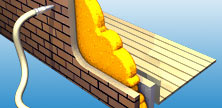Cavity wall insulation
In the UK houses built from 1920 onwards were built with external walls made of two layers with a small gap or 'cavity' between them. This means they are 'cavity walls'. The air gap works in the same way as the air gap in double glazing and made the homes more energy efficient than the old solid brick ones. However today we can improve on cavity walls by filling the gap with insulating foam.
Heat will always flow from a warm area to a cold one. In winter, the colder it is outside, the faster heat from your home will escape into the surrounding air. Cavity wall insulation slows down the rate at which it escapes, keeping as much of it as possible inside your home for as long as possible. Cavity wall insulation makes it much more difficult for heat to pass through your walls by filling up the cavity with a material with lots of small air pockets in it. These pockets are more efficient at reducing heat transfer by convection than the big air cavity was. They make it impossible for large convection currents to be set up. They greatly reduce what is known as your walls' U value - which is a measure of how quickly they lose heat - from around 1.5 Wm-2K-1 to 0.5 Wm-2K-1 . The lower the U value, the slower heat transfer - and the less energy you need to keep your home warm. Heat transfer by convection is reduced by making the air pockets very tiny - reducing the size of convection currents Heat transfer by conduction is kept as low as that of cavity walls because the plastic foam is a good insulator - just like dry air is.
|
Follow me...
|







